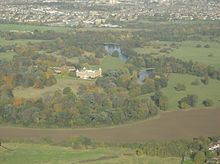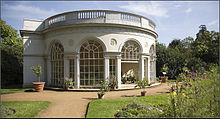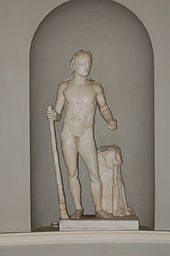- Osterley Park
-
Osterley Park 
Osterley ParkType Historic house Proprietor National Trust Main feature Robert Adam architecture Other features 18th-century gardens Public access Yes Exhibition Yes Region Greater London Address Jersey Road, Isleworth, Postcode TW7 Refreshments Yes Parking Yes Shop Yes (and farmshop) Website NT Osterley Park and House 51°29′21.75″N 00°21′07.14″W / 51.489375°N 0.3519833°WCoordinates: 51°29′21.75″N 00°21′07.14″W / 51.489375°N 0.3519833°W Osterley Park is a mansion set in a large park of the same name. It is in the London Borough of Hounslow, part of the western suburbs of London. When the house was built it was surrounded by rural countryside. It was one of a group of large houses close to London which served as country retreats for wealthy families, but were not true country houses on large agricultural estates. Other surviving country retreats of this type near London include Syon House and Chiswick House. The park is one of the largest open spaces in west London, though it is marred by the presence of the M4 motorway, which cuts across the middle of it.
Contents
History
Elizabethan
The original building on this site was a manor house built in the 1570s for banker Sir Thomas Gresham, who purchased the manor of Osterley in 1562.[1]The "faire and stately brick house" was complete in 1576. It is known that Queen Elizabeth visited.[2] The stable block from this period remains at Osterley Park. Gresham was so wealthy he also bought the neighbouring Manor of Boston in 1572. His widowed stepdaughter-in-law built the present Jacobean manor house there which still stands to this day.[citation needed]
Child and Adam
Two hundred years later the manor house was falling into disrepair, when, as the result of a mortgage default, it came into the ownership of Sir Francis Child, the head of Child's Bank. In 1761 he employed Robert Adam, who was just emerging as one of the most fashionable architects in England, to remodel the house. When Sir Francis died in 1763, the project was taken up by his brother and heir Robert Child, for whom the interiors were created.
The house is of red brick with white stone details and is approximately square, with turrets in the four corners. Adam's design, which incorporates some of the earlier structure, is highly unusual, and differs greatly in style from the original construction. One side is left almost open and is spanned by an Ionic pedimented screen which is approached by a broad flight of steps and leads to a central courtyard, which is at piano nobile level.
Adam's neoclassical interiors are among his most notable sequences of rooms. Horace Walpole sarcastically described the drawing room as "worthy of Eve before the fall." The rooms are characterised by elaborate but restrained plasterwork, rich, highly varied colour schemes, and a degree of coordination between decor and furnishings unusual in English neoclassical interiors. Notable rooms include the entrance hall, which has large semi-circular alcoves at each end, and the Etruscan dressing room, which Adam said was inspired by the Etruscan vases in Sir William Hamilton's collection, illustrations of which had recently been published. Adam also designed some of the furniture, including the opulent domed state bed, still in the house.
After Child
Robert Child's only daughter, Sarah Anne Child, married John Fane, 10th Earl of Westmorland in 1782. When Child died two months later, his will placed his vast holdings, including Osterley, in trust for his eldest granddaughter, Lady Sarah Sophia Fane, who was born in 1785. She married George Child-Villiers, 5th Earl of Jersey, and thus Osterley passed into the Jersey family.
Home Guard Training Establishment
The grounds of Osterley Park were used for the training of the first members of the Local Defence Volunteers (forerunners of the Home Guard) when the 9th Earl, a friend of publisher Lord Hulton, allowed writer and military journalist Captain Tom Wintringham to establish the first Home Guard training school (which Hulton sponsored) at the park in May/June 1940, teaching the theory and practice of modern mechanical warfare, guerilla warfare techniques and using the estate workers' homes, then scheduled for demolition, to teach street fighting techniques.[3] The painter Roland Penrose taught camouflage techniques here,[4] attempting to disguise the obvious charms of a naked Lee Miller. Maj. Wilfred Vernon taught the art of mixing home made explosives, and his explosives store can still be seen at the rear of the house, while Canadian Bert "Yank" Levy, who had served under Wintringham in the Spanish Civil War taught knife fighting and hand to hand combat. Despite winning world fame in newsreels and newspaper articles around the world (particularly in the US), the school was disapproved of by the War Office and Winston Churchill, and was taken over in September 1940 and closed in 1941, the staff and courses reallocated to other newly opened WO approved Home Guard schools.[3]
Postwar history
In 1947 a Ministry of Works team, including architect E.T. Spashett, converted the building for use as a convalescence home for injured airmen.[5] George Child-Villiers, 9th Earl of Jersey gave the house and much of the estate to the National Trust in 1949. It is now open to the public, and contains most of the original furniture in excellent condition.
In popular culture
Television
- Osterley Park was originally proposed as the setting (and location) for the 1973 Doctor Who serial Day of the Daleks. The name was changed to "Auderley" in the finished programme, and was renamed "Austerley" in the novel of the serial. The location eventually used was Dropmore Park in Buckinghamshire.
- The entrance hall of the house also appeared as a room in an upmarket central London hotel in the denouement of the 2007 ITV adaptation of At Bertram's Hotel.
- Osterley Park was used as the home of billionaire Sir Peter Maxwell, for the 2006 TV pilot, 'Maxwell: Inside the Empire'.
- Chucklevision was also filmed in Osterley Park.
- The house featured in an episode of 1970s cult series The Persuaders which starred Roger Moore and Tony Curtis.
Music
- A wall in the park was used as the background to the cover picture of the 1973 Wings album Band on the Run.
Film
- The 1960 film The Grass Is Greener, starring Cary Grant, Deborah Kerr and Robert Mitchum, was set and partly shot at Osterley Park House.
- The 2001 film Kabhi Kushie Kabhi Gham, starring Shah Rukh Khan and Kajol, the garden reunion scene.
- Osterley Park has been used for Buckingham Palace scenes, including Victoria's sitting room and anteroom, in the 2009 film The Young Victoria starring Emily Blunt and Rupert Friend.
- The 1984 film "Top Secret!", starring Val Kilmer and Omar Sharif, features Osterley as East Berlin Town Hall, when the various cultural ambassadors are presented with medals by the East German Women's Olympic Team.
- In the upcoming 2012 Batman film The Dark Knight Rises, starring Christian Bale, the interior of Osterley Park mansion is used as a double for Wayne Manor. [6]
Literature
- Osterley Park features in John Banville's novel The Untouchable.
References
- ^ John Hardy and Maurice Tomlin, Osterley Park House, (Victoria and Albert Museum) 1985.
- ^ Jayne Elisabeth Archer, Elizabeth Clarke, and Elizabeth Goldring, eds, John Nichols' The Progresses and Public Processions of Queen Elizabeth I: A New Edition of the Early Modern Sources, V: Appendices, Bibliographies, and Index. Appendix 7: Sir Thomas Gresham and Osterley Park
- ^ a b Tom Wintringham (History Learning Site) accessed 29 Jan 2008
- ^ Newark, Tim Now you see it... Now You Don't, (March 2007) History Today
- ^ Information from the archives of E.T. Spashett ARIBA (to be donated to RIBA archives in 2009 after cataloguing)
- ^ http://www.movieweb.com/news/the-dark-knight-rises-wayne-manor-photo
External links
- Osterley Park information at the National Trust
- Aerial photo and map
- Flickr images tagged Osterley Park
Museums and galleries in London National museums
and galleriesBritish Library · British Museum · Imperial War Museum (Churchill War Rooms · HMS Belfast) · National Army Museum · National Gallery · National Maritime Museum (Queen's House · Royal Observatory) · Natural History Museum · National Portrait Gallery · Science Museum · Tate (Tate Britain · Tate Modern) · Victoria and Albert Museum (Museum of Childhood)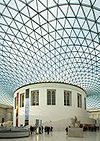
Designated collections Courtauld Gallery · Dulwich Picture Gallery · Firepower – The Royal Artillery Museum · Horniman Museum and Gardens · Hunterian Museum · Jewish Museum · Kensington Palace (Dress collection) · Library and Museum of Freemasonry · London Transport Museum · Museum of Domestic Design and Architecture · Museum of London (Museum of London Docklands) · Petrie Museum · Sir John Soane's MuseumEnglish Heritage Apsley House · Chiswick House · Down House · Eltham Palace · Jewel Tower · Kenwood House (Iveagh Bequest) · London Wall · Marble Hill House · Ranger's House (Wernher Collection) · Winchester PalaceNational Trust 2 Willow Road · Blewcoat School · Carlyle's House · Eastbury Manor House · Fenton House · George Inn · Lindsey House (restricted) · Morden Hall Park · Osterley Park · Rainham Hall · Red House · Roman Baths · Sutton HouseOther museums
and galleriesBarbican Art Gallery · Bruce Castle · Design Museum · Estorick Collection · Foundling Museum · Freud Museum · Garden Museum · Geffrye Museum · Guildhall Art Gallery · Handel House Museum · The Hayward · Hogarth's House · Institute of Contemporary Arts · Leighton House Museum · Museum of Brands, Packaging and Advertising · Old Operating Theatre · Queen's Gallery (Royal Collection) · Royal Academy of Arts · Royal Academy of Music Museum · Saatchi Gallery · Serpentine Gallery · Sherlock Holmes Museum · Wallace Collection · Wellcome Collection · Whitechapel Gallery · William Morris GalleryParks and open spaces in London Royal parks Bushy · Green · Greenwich · Hyde · Kensington · Regent's · Richmond · St James's
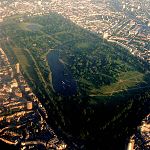
Large urban parks Alexandra · Battersea · Blackheath · Burgess · Crystal Palace · Finsbury · Hampstead Heath · Parliament Hill · Southwark · Victoria · Wimbledon
Country parks Bayhurst Wood · Belhus Woods · Eastbrookend · Fairlop Waters · Fryent · Hainault Forest · Havering · High Elms · Hornchurch · Lee Valley · South Norwood · Stanmore · Stockley · Trent
Commons Barnes · Bromley · Cannon Hill · Clapham · Eel Brook · East Sheen · Ham · Hayes · Kenley · Mitcham · Old Oak · Peckham Rye · Plumstead · Putney · Putney Lower · Stanmore · Stoke Newington · Streatham · Tooting · Tylers · Wandsworth · Wimbledon · Winn's
Marshes Aveley · Crayford · Erith · Hackney · Hornchurch · Ingrebourne · Leyton · Rainham · Tottenham · Walthamstow · Wennington
Woodland Bostall · Coldfall · Dulwich · Epping Forest · Grangewood Park · Highgate · Lesnes Abbey · Oxleas · Queen's · Russia Dock · Sydenham Hill
House gardens Belair Park · Boston Manor House · Cannizaro Park · Danson Park · Grovelands Park · Grove Park · Hampton Court Park · Kenwood House · Langtons · Morden Hall Park · Osterley Park · Syon House
Entry-fee charging Community gardens Phoenix Garden · Calthorpe Project
Parks and open spaces by London borough Barking and Dagenham · Barnet · Bexley · Brent · Bromley · Camden · Croydon · Ealing · Enfield · Greenwich · Hackney · Hammersmith and Fulham · Haringey · Harrow · Havering · Hillingdon · Hounslow · Islington · Kensington and Chelsea · Kingston · Lambeth · Lewisham · Merton · Newham · Redbridge · Richmond · Southwark · Sutton · Tower Hamlets · Waltham Forest · Wandsworth · Westminster
Categories:- Gardens in London
- Grade I listed buildings in London
- National Trust properties in London
- Parks and open spaces in Hounslow
- Historic house museums in London
Wikimedia Foundation. 2010.


